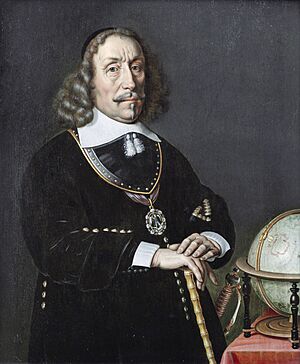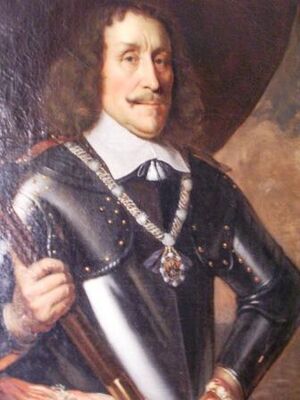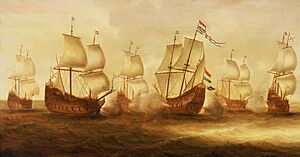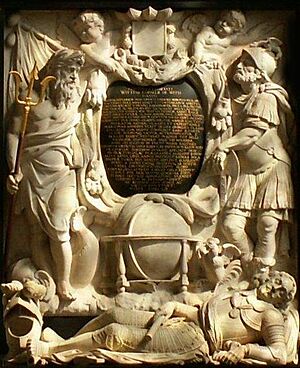Witte de With facts for kids
Quick facts for kids
Witte de With
|
|
|---|---|

Witte de With by Abraham van Westerveld
|
|
| Birth name | Witte Corneliszoon de With |
| Nickname(s) | Dubbelwit |
| Born | 28 March 1599 Brielle, Dutch Republic |
| Died | 8 November 1658 (aged 59) Øresund, Denmark |
| Buried |
Grote of Sint-Laurenskerk, Rotterdam
|
| Allegiance | |
| Years of service | 1616–1658 |
| Battles/wars | Eighty Years' War
|
Imagine a time when brave sailors explored the world and fought epic sea battles. One such sailor was Witte Corneliszoon de With (born March 28, 1599 – died November 8, 1658). He was a famous Dutch naval officer. Witte de With played a big part in important wars like the Eighty Years' War and the First Anglo-Dutch War. He was known for being a very strict leader, but also a very skilled and courageous sailor.
Contents
Witte de With's Early Life
Witte de With was born on a farm near Brielle, a town in the Dutch Republic. Interestingly, another famous Dutch admiral, Maarten Tromp, was born in the same town just a year before him. Some stories say they were friends or even rivals when they were young, but we don't have proof of that.
Witte's father passed away in 1602, leaving his mother to raise Witte and his three siblings. His family were Mennonites, a group known for being very peaceful. However, Witte chose to be baptized by a Calvinist preacher in 1610.
First Adventures at Sea
After trying a few small jobs that didn't work out, Witte de With decided to go to sea. When he was just sixteen, he joined a fleet of five ships from the Dutch East India Company (VOC). He started as a cabin boy on a ship called the Gouden Leeuw on January 21, 1616.
He sailed all the way to Bantam in what is now Indonesia, arriving in November 1616. For about a year, he took part in two trading trips to Coromandel in India. Later, he became a personal assistant to the governor, Jan Pieterszoon Coen. He even served as a corporal during the siege of Jakarta in 1618.
Witte returned home in May 1619. In 1620, he joined the navy as a schipper, which was a high rank for a non-commissioned officer. He sailed on the Gelderland and helped fight against Barbary Corsairs, who were pirates.
Becoming a Captain
In 1622, Witte de With became a lieutenant. He even acted as captain of the Gelderland for a while when his captain was sick. He helped protect fishing fleets in the Baltic Sea.
Later, in 1623, he became the flag captain of the Delft. This ship was part of a special fleet called the "Nassau fleet" that sailed around Cape Horn to attack Spanish areas in America. This was his first time as a captain. Even then, Witte de With was known for being very strict. Six of his men even ran away from his ship to an island because of his tough rules!
During these attacks, Witte de With was wounded by a musket bullet. The fleet then crossed the Pacific Ocean to the Spice Islands.
A Trip Around the World
In 1625, Witte de With helped destroy many clove trees on an island to make the price of this spice go up. He left for home in February 1626, after his admiral died. He was now a Vice-Admiral for the Dutch East India Company, leading a fleet of four ships.
He arrived back in the Netherlands in September 1626, having sailed all the way around the world! This was a huge achievement that he was very proud of.
Capturing Spain's Treasure Fleet
In 1628, Witte de With joined the Dutch West India Company (WIC). He became the flag captain for Admiral Piet Heyn on the ship Amsterdam. Their mission was to capture the Spanish treasure fleet.
In September, they succeeded near Cuba! They captured a huge amount of treasure, worth about eleven million guilders. Witte de With was given about 500 guilders, but he was very unhappy. He felt he deserved more because he had captured a small boat whose crew gave them important information about where the treasure fleet was.
Witte de With hoped to get a higher position, but another admiral, Maarten Tromp, was chosen instead. Disappointed, Witte de With left the navy for a while in 1629.
The Battle of the Downs
Both Witte de With and Maarten Tromp had left the navy for a time due to disagreements with other leaders. But they were two of the most skilled Dutch naval officers. In 1637, the Dutch navy was having problems, and the country needed its best sailors.
So, on October 29, Witte de With and Tromp were brought back into the navy. Witte de With was again disappointed because he wasn't given the top command. Instead, he became second-in-command under Lieutenant-Admiral Tromp.
Witte de With fought bravely under Tromp at the Battle of the Downs in 1639. In this battle, the Spanish fleet was completely defeated. However, Witte de With became very jealous of Tromp's popularity after this big victory. He also made an enemy of another admiral, Johan Evertsen, accusing him of not being brave enough.
Facing a Court Trial
In 1640, Witte de With faced a trial. His fleet had been scattered by a storm, and he returned to port alone. The trial was led by Maarten Tromp. Even though Witte de With was found innocent, he believed that Tromp had tried to turn witnesses against him.
Later, in 1644 and 1645, Witte de With led huge convoys of merchant ships (once with 702 ships!) through the Sound. He forced the Danes, who were trying to charge higher tolls, to let them pass. This showed the power of the Dutch navy in the Baltic Sea.
In 1647, Witte de With was sent with a poorly supplied fleet to help the Dutch colony in Brazil against the Portuguese. He had many conflicts with the local leaders. After months of problems, he returned to the Netherlands in 1649, even though he was told not to.
When he arrived, he complained about the colony's policies. But he was arrested himself! He was accused of not following orders and leaving his post. He almost faced a very serious punishment, but the States of Holland stepped in and saved him. In 1651, he was found innocent of most charges, and his punishment was reduced to losing his pay for that time.
The First Anglo-Dutch War
The First Anglo-Dutch War started against England. In 1652, when Admiral Maarten Tromp was temporarily out of favor, Witte de With commanded the Dutch fleet at the Battle of the Kentish Knock. However, he didn't succeed in his mission.
Feeling defeated, he was sick at home for many months. During this time, Tromp took command again. Witte de With later fought under Tromp in other big battles, like the Battle of the Gabbard and the final Battle of Scheveningen, where Tromp sadly died.
Witte de With was a temporary commander for a short time after Tromp's death. But because of his difficult personality, he was not given permanent command of the Dutch fleet.
Conflict with Denmark
After a war between Sweden and Denmark, the Dutch hoped that Denmark would lower its tolls (fees) for ships passing through the Sound. When this didn't happen, tensions grew.
In 1645, a fleet of 48 ships led by Witte de With, escorting three hundred merchant ships, sailed through the Sound. Their goal was to pay no tolls until Denmark lowered them. Witte de With was told to use force if the Danes tried to stop them.
When he arrived, the Danish king, Christian IV, came to see it himself. Witte de With saluted him, but the king didn't respond, which the Danes saw as an insult. The Dutch fleet stayed put, and King Christian IV realized he had to give in. A treaty was signed, and the Danes made big concessions.
Death in Battle
Witte de With died in November 1658 during the Battle of the Sound. This battle was part of the Northern Wars, and the Dutch fleet was trying to help Copenhagen against the Swedes.
His ship, the Brederode, got stuck and was surrounded by enemy ships. He was shot twice. The Swedes gave his body to the Danish court in Copenhagen. After the Danes honored him, his body was sent to the Netherlands.
Witte de With was buried with great ceremony in Rotterdam on October 7, 1659. His marble grave memorial can still be seen in the church of St Lawrence. It was even repaired after being damaged during a bombing in 1940.
His Rivalry with Tromp
Witte de With had a long-lasting rivalry with Admiral Maarten Tromp. A historian once said that Witte de With was "feared and hated by his inferiors... shunned by his equals and always full of insubordination against his superiors."
However, everyone also agreed that Witte de With was very brave, skilled, and an excellent sailor. He was often frustrated by how the Dutch fleet was managed between 1639 and 1650.
A Writer of Pamphlets
One interesting thing about Witte de With was that he loved to write and publish small booklets, called pamphlets. He would publish them anonymously or under his friends' names. In these booklets, he sometimes praised, but more often made fun of or even insulted, his fellow officers. Admiral Tromp was a favorite topic for him!




